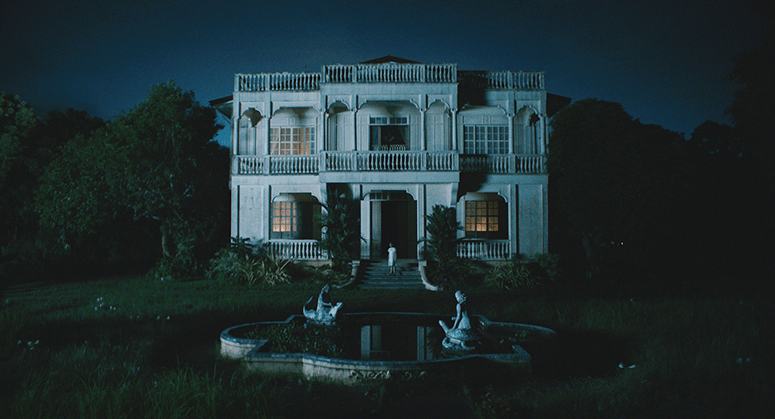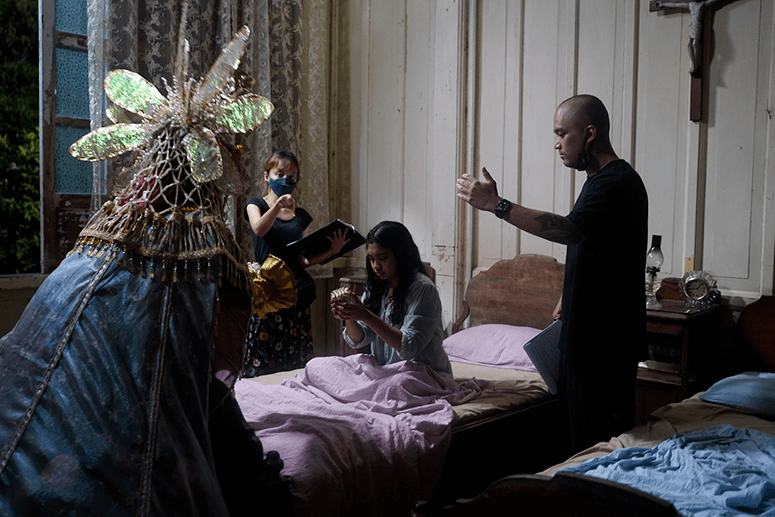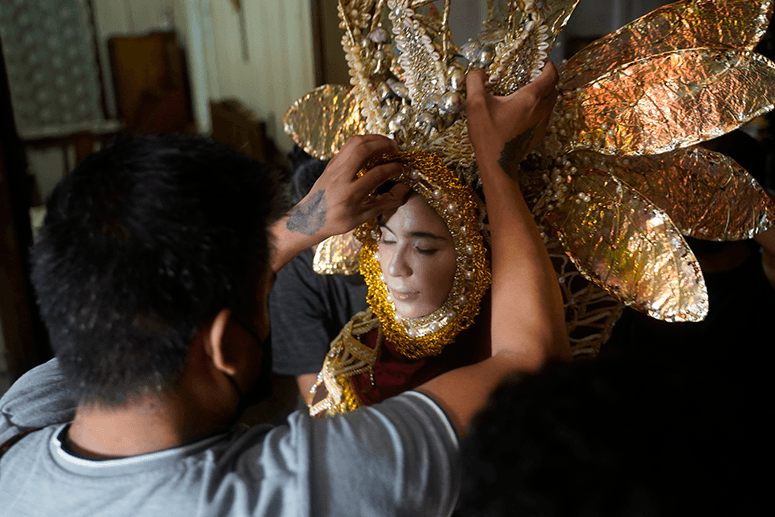Filipino folklore takes a grim turn in this surreal horror film
“It’s a bit surreal,” writer-director Kenneth Dagatan told Young STAR when asked about his reaction upon seeing his film In My Mother's Skin for the first time on the big screen in Park City, Utah.
In My Mother's Skin debuted at the 2023 Sundance Film Festival under the Midnight Section, where notable horror films such as The Witch by Robert Eggers and Hereditary by Ari Aster had its world premiere in the past. For the second year in a row, a Filipino feature film made it to Sundance, following Leonor Will Never Die by Martika Ramirez Escobar. It also screened at the 2023 International Film Festival Rotterdam’s Harbour Section. Prior to Sundance, the film has already been acquired by Amazon Prime Video for VOD streaming later this year.
While In My Mother’s Skin is the lone Filipino feature film in Sundance this year (“a dream come true,” according to Dagatan), more Filipino talents have been recognized in the festival’s short film program, including the Short Film Grand Jury Prize-winning When You Left Me On That Boulevard by Kayla Abuda Galang, The Vacation by Jarreau Carrillo (who won the Short Film Special Jury Award for Directing), and It’s Raining Frogs Outside by Maria Estela Paiso.
Only Dagatan’s sophomore feature In My Mother’s Skin is turning out to be a remarkable feat. Glowing reviews have been pouring in, alongside an 89% rating on Rotten Tomatoes as of writing. Set in the Philippines under Japanese occupation, the film chronicles the story of Tala (Felicity Kyle Napuli), the young heroine who innocently puts her faith in a flesh-eating fairy (Jasmine Curtis-Smith) in hopes of saving her ailing mother (Beauty Gonzalez). Little does she know that this moment of salvation comes at a great cost.
In My Mother's Skin is magical realism, folk horror, and historical allegory all rolled into one, uprooting the measures people are willing to take, especially when their lives are on the line.
Dagatan, however, tabled the idea of In My Mother’s Skin gracing Sundance. “If you’re in the middle of development, you don’t really think about where the film is going because you’re focused on making the best version of the film,” he said.
We were able to tell these layers in a universal way, and I realized that there’s no language [and] cultural barrier.
That is, until the news came. “I received a message from my producer, Bradley [Liew], saying there’s an emergency. We were in the middle of post-production, and I was a bit anxious about everything at this point. I called him several times, but he [didn’t] answer. So I messaged his wife, a producer of the film as well, Bianca Balbuena [about the emergency]. And she just told me casually that we got into Sundance and Brad is just hyping it up.”

It’s safe to say that In My Mother’s Skin has defied statistical impossibility, given how big Sundance is and how it has taken Dagatan seven years to put the film to the screen, largely due to budget constraints. In fact, the filmmaker had just completed his college degree at the University of San Carlos in Cebu when he set the springboard for the film.

This is the third installment in Dagatan’s “mother” trilogy, the others being Sanctissima, which competed at the short film category of the 2015 Cinemalaya Film Festival and earned the Audience Choice Award, and his debut feature Ma, an entry at the 2019 New York Asian Film Festival.

“I wrote In My Mother’s Skin as a short film and the goal was to [make] another short film that has the same elements as Sanctissima to prepare myself [for] creating feature films, but it didn’t happen,” Dagatan said.
Replete with political and cultural undertones, In My Mother's Skin is not only unique in terms of its phantasmagorical realm but also in the zeitgeist it operates in. While Dagatan originally wrote the film sans a particular milieu, this detail took a turn amid the pandemic. “I was talking with my father, and he told me the story of my grandfather, who was a guerrilla soldier back in World War II, and how the war impacted my grandmother, who was escaping the war with their two children. The physical and mental impact of the war reminded me of the pandemic — different faces of grief and fear, but the same monster.”

And so it became significant to scout a location that would perfectly bring this vision to life; in this case, the Gaston Mansion in Hacienda Rosalia in Negros, the same estate found in the Filipino classic Oro, Plata, Mata by Peque Gallaga. “While writing the script, I rewatched Oro Plata Mata and Tatlong Taong Walang Diyos [by Mario O’Hara] a couple times to [get a] sense of the milieu of World War II in the Philippines and studied the Oro Plata Mata house for the geography of our film,” Dagatan said.
“In pre-production, we visited some ancestral houses, but it didn’t fit the story. So I asked my producers if we can check the Oro Plata Mata house, if we can film there. We visited the Gaston House, and the first time I saw it, I told everyone that this is the house, and we need to shoot it here,” the director added.
Even Dagatan’s Cebuano roots helped shape his creative process and storytelling for the film. “Culture, childhood, and home really have a big impact on what we do. You start to put personal stuff as you create something, subconsciously or consciously. And in In My Mother's Skin, I tried to put Cebuano elements on the design aspect, like the fair-engkanto’s costume, which is based on the Santo Niño.”

But Dagatan also had reservations about how to translate these specific references to an assured visual language, since In My Mother's Skin is the first co-production between the Philippines (Epicmedia), Singapore (Zhao Wei Films and Clover Films), and Taiwan (Volos Films). “At first I was doubtful because of the culture and language barrier. I wanted to tell a Filipino film, but I also thought it would be a great opportunity to work with a foreign crew,” he said.

“In the pre-production, me and my cinematographer Russel [Morton] discussed the themes that I wanted to discuss. I was surprised that the themes I thought were uniquely Filipino resonated with him and his culture. It’s the same with my editor Zeek [Kao Ming-Sheng]. We were able to tell these layers in a universal way, and I realized that there’s no language [and] cultural barrier [because] we’re working with one language, which is cinema.”

Who would have thought that Dagatan never saw this filmmaking career coming? “During college I didn’t really expect that I [would] pursue this career path. I was a musician back then and really wanted to pursue music,” he said.
Dagatan was a former member of the local punk rock band Drop Decay (whose early music I was fortunate to follow) when he decided to move from Cebu to Manila, eventually lending his artistic prowess to projects like Topel Lee’s Bloody Crayons, Rae Red’s Tenement 66, and Cignal Play’s anthology series Now Streaming.
With In My Mother’s Skin under his belt, Dagatan’s gamble is now beginning to pay off. And the filmmaker said he owes this career turn to his brother, who introduced him to the craft (“He taught me how to edit when I was in high school”), and to his mentor Ruel Antipuesto, who brought him closer to “the philosophy and the power of storytelling and cinema.” “It really changed how I view cinema and the world now because of him.”
Horror, lived or imagined, is seemingly part and parcel of living in the Philippines, and Dagatan’s “In My Mother’s Skin” at its core, creates a snapshot of this ever-growing rot that routinely and violently consumes us alive.


